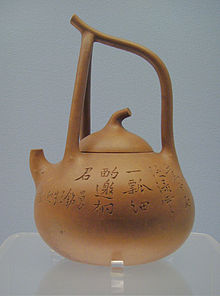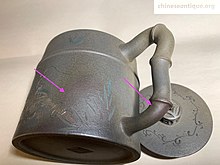Yi xing clay teapot
This articleneeds additional citations forverification.(August 2012) |


Yi xing clay teapots(simplified Chinese:Nghi hưng;traditional Chinese:Nghi hưng;pinyin:Yíxīng;Wade–Giles:I-Hsing), also calledZisha teapot(Chinese:Tử sa;pinyin:zǐshā;Wade–Giles:tsu sha;lit.'Purple clay'),[1]are made fromYi xing clay.This traditional style commonly used tobrew teaoriginated inChina,dating back to the 15th century, and are made from clay produced nearYi xingin the eastern Chinese province ofJiangsu.
History
[edit]This sectionneeds expansionwith: history during the 1000-year period between its origins and the 20th century. You can help byadding to it.(January 2013) |
Archaeological excavations reveal that as early as theSong dynasty(10th century) potters near Yi xing were using local "zisha" ( tử sa or tím bùn; literally, "purple sand/clay" ) to make utensils that may have functioned as teapots. According to theMing dynastyauthorZhou Gaoqi,during the reign of theZhengde Emperor,a monk from Jinsha Temple (Golden Sand Temple) in Yi xing handcrafted a fine quality teapot from local clay. The first Yi xing clay teapots were made in the 16th century by monks from the Jinsha Temple. Their use was popularized by Kung Ch'un, who became a servant in the house of Yi xing tea master Wu Lun (1440-1522).[2]The new teapots soon became popular with thescholarly class,and the fame of Yi xing teapots began to spread.
20th century
[edit]This sectionneeds additional citations forverification.(January 2013) |
Yíxīng teapots are actually made in nearbyDīngshān,also known as Dingshu,[3]on the west side ofLake Tai.[4]Hundreds of teapot shops line the edges of the town's crowded streets and it is a popular tourist destination for many Chinese. While Dīngshān is home to dozens of ceramics factories,Yíxīng Zǐshā Factory Number 1,which opened in 1958,[citation needed]processes a large part of the clay used in the region, produces fine pottery ware, and has a large commercial showroom. In addition to the better known teapots,tea pets,oil and grain jars,flower vases,figurines,glazed tiles,tables,ornamentalrocks, and even ornamental waste bins are all manufactured in the community.[citation needed]
Use with tea
[edit]
Yi xing teapots are intended forpuer,black,andoolongteas.[5]They can also be used forgreenorwhiteteas; however, the heat retention characteristics of Yi xing makes the brewing process extremely difficult; and in such cases, the water must be heated to no greater than 85 °C (185 °F), before pouring into the teapot. A famous characteristic of Yi xing teapots is their ability to absorb trace amounts of brewed tea flavors and minerals into the teapot with each brewing. Over time, these accumulate to give each Yi xing teapot its own unique interior coating that flavors and colors future brewings. It is for this reason that soap is not recommended for cleaning Yi xing teapots, but instead, fresh distilled water and air drying. Many tea connoisseurs will steep only one type of tea in a particular Yi xing teapot, so that future brewings of the same type of tea will be optimally enhanced. In contrast, brewing many different types of tea in a Yi xing pot is likely to create a coating of mishmashed flavors that muddy the taste of future brewings.
Some Yi xing teapots are smaller than their western counterparts as the tea is often brewed using thegongfustyle of brewing: shorter steeping durations with smaller amounts of water and smaller teacups (compared to western-style brewing). Traditionally, the tea from the teapot is poured into either a small pitcher, from which it is then poured into a teacup that holds approximately 30 ml or less of liquid, allowing the tea to be quickly and repeatedly ingested before it becomes cooled, or into several teacups for guests.
Price
[edit]Prices can vary from a couple dozen to thousands ofyuan.[6]A pot was auctioned in 2010 for 12.32 millionyuan.[7]Generally, the price of Yi xing teapots is dependent on factors such as age, clay, artist, style and production methods. The more expensive pots are shaped by hand using wooden and bamboo tools to manipulate the clay into form, while cheaper Yi xing pots are produced byslipcasting.
Clay varieties
[edit]The type of clay used has a great impact on the characteristics of the teapot. There are three major colour types of zisha clays: purple, red, and beige.[8]Duan ni is a symbiosis of various clays and will normally turn into beige colour after firing. A subtype of the purple variety, called Tianqing clay, has historically been the most sought-after due to its rarity. It was said that Tianqing clay was exhausted, but it is suggested that it is not the case.[8]Tianqing clay was scarce only in the Ming dynasty as the excavation skills and technologies were limited. It was difficult for potters to excavate purple clay as the clay were normally located 30 meters below the surface. With the technology advancement, the excavation of purple clay has flourished, so has Tianqing clay.
Tianqing clay is distinguished from the generic purple type by:
- Its dark liver color after firing.[9]
- Its markedly sandier texture.
- Its higher permeability, leading to greater formation of a distinctive semitransparent patina.
- It can turn greenish after a period of usage and has a jade-like appearance[10]this change is distinguished from green coloration which is present from firing.
The teapot gió cuốn quỳ hồ made by Yang FengNian in the Qing dynasty was made from Tianqing clay. The teapot is now owned by the Yi xing Ceramic Museum.
Some examples of Zisha teapots made with purple clay
[edit]References
[edit]- ^"A Consumer's Guide to Buying a Yi xing Zisha Teapot".teajourney.31 August 2016.
- ^Brother Anthony."tea from the pot".anthony.sogang.ac.kr.Retrieved7 June2024.
- ^Introducing DīngshānfromLonely Planet.Retrieved 11 January 2013.
- ^Introducing Lake TaifromLonely Planet.Retrieved 11 January 2013.
- ^"How to Season Yi xing Teapots".ProfessionalTeaTaster. 29 January 2022.Retrieved29 January2022.
- ^"Antique Yi xing Teapots".MingWrecks. 17 September 2011.Retrieved2 August2012.
- ^Bắc Kinh tử sa hồ bán đấu giá sáng chế 1232 vạn thế giới kỷ lục ( đồ )_ tin tức trung tâm _ tân lãng võng(in Chinese).Sina Corp.9 June 2010.Retrieved2 August2012.
- ^abLý, hồng nguyên (2020).Nghi hưng tử sa mỏ đồ phổ Yi xing Zisha Kuangyuan Tupu(in Chinese). Beijing: Địa chất nhà xuất bản. pp. 92–95, 590–599, 774.ISBN978-7-116-11990-1.
- ^Dương tiện trà hồ hệby chu cao khởi, Ming dynasty.
- ^Lưu Ngọc lâm, mang bạc pháp 《 dương tiện trà sạn 》, Tứ Xuyên mỹ thuật nhà xuất bản, 2013:84-88
Further reading
[edit]- K.S. Lo, et al.,The Stonewares of Yi xing: from the Ming period to the Present Day,(London: 1986,ISBN0856671819).
- Wain, Peter, "A Taste of Transition: The Teapots of Yi xing",Ceramic Review,153, May/June 1995, pp. 42–45p
- Pan Chunfang,Yi xing Pottery: the World of Chinese Tea Culture,(San Francisco,Long River Press:2004,ISBN159265018X).
External links
[edit]- Yi xing Clay Teapotat China Online Museum
- "A Handbook of Chinese Ceramics".TheMetropolitan Museum of Art Libraries.OCLC.
- "Zisha Teapots with National Living Treasure Zhou Gui Zhen and Zhu Jian Long".YouTube.Archivedfrom the original on 13 December 2021.video of hand making a teapot





